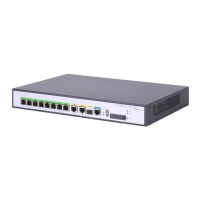560
Usage guidelines
Applying an attack defense policy to a device can improve the efficiency of processing attack packets
destined for the device.
Each device can have only one attack defense policy applied. If you use this command multiple times, the
most recent configuration takes effect.
An attack defense policy can be applied to the device locally and to multiple interfaces.
If a device and its interfaces have attack defense policies applied, a packet destined for the device is
processed as follows:
1. The policy applied to the receiving interface processes the packet.
2. If the packet is not dropped by the receiving interface, the policy applied to the device processes
the packet.
Examples
# Apply attack defense policy atk-policy-1 to the device.
<Sysname> system-view
[Sysname] attack-defense local apply policy atk-policy-1
Related commands
• attack-defense policy
• display attack-defense policy
attack-defense policy
Use attack-defense policy to create an attack defense policy and enter its view.
Use undo attack-defense policy to remove the specified attack defense policy.
Syntax
attack-defense policy policy-name
undo attack-defense policy policy-name
Default
No an attack defense policy exists.
Views
System view
Predefined user roles
network-admin
Parameters
policy-name: Assigns a name to the attack defense policy. The policy name is a case-insensitive string of
1 to 31 characters. Valid characters include uppercase and lowercase letters, digits, underscores (_), and
hyphens (-).
Examples
# Create attack defense policy atk-policy-1 and enter its view.
<Sysname> system-view
[Sysname] attack-defense policy atk-policy-1

